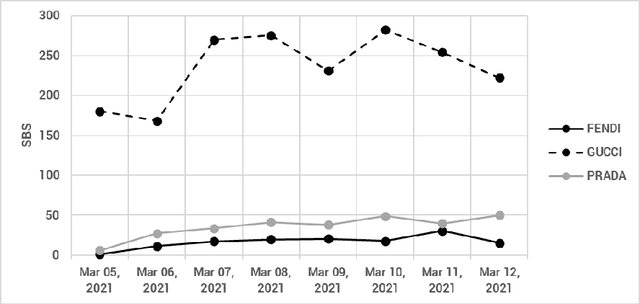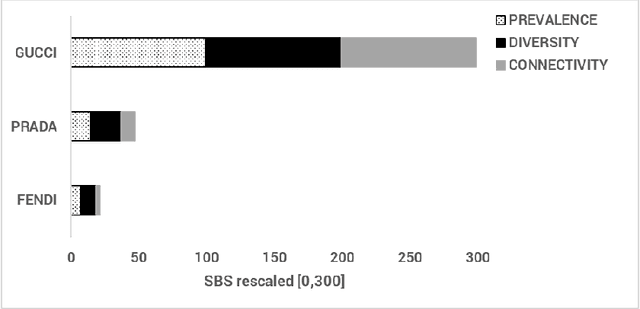F. Grippa
A new system for evaluating brand importance: A use case from the fashion industry
Jun 24, 2021



Abstract:Today brand managers and marketing specialists can leverage huge amount of data to reveal patterns and trends in consumer perceptions, monitoring positive or negative associations of brands with respect to desired topics. In this study, we apply the Semantic Brand Score (SBS) indicator to assess brand importance in the fashion industry. To this purpose, we measure and visualize text data using the SBS Business Intelligence App (SBS BI), which relies on methods and tools of text mining and social network analysis. We collected and analyzed about 206,000 tweets that mentioned the fashion brands Fendi, Gucci and Prada, during the period from March 5 to March 12, 2021. From the analysis of the three SBS dimensions - prevalence, diversity and connectivity - we found that Gucci dominated the discourse, with high values of SBS. We use this case study as an example to present a new system for evaluating brand importance and image, through the analysis of (big) textual data.
Aristotle Said "Happiness is a State of Activity" -- Predicting Mood through Body Sensing with Smartwatches
May 24, 2021



Abstract:We measure and predict states of Activation and Happiness using a body sensing application connected to smartwatches. Through the sensors of commercially available smartwatches we collect individual mood states and correlate them with body sensing data such as acceleration, heart rate, light level data, and location, through the GPS sensor built into the smartphone connected to the smartwatch. We polled users on the smartwatch for seven weeks four times per day asking for their mood state. We found that both Happiness and Activation are negatively correlated with heart beats and with the levels of light. People tend to be happier when they are moving more intensely and are feeling less activated during weekends. We also found that people with a lower Conscientiousness and Neuroticism and higher Agreeableness tend to be happy more frequently. In addition, more Activation can be predicted by lower Openness to experience and higher Agreeableness and Conscientiousness. Lastly, we find that tracking people's geographical coordinates might play an important role in predicting Happiness and Activation. The methodology we propose is a first step towards building an automated mood tracking system, to be used for better teamwork and in combination with social network analysis studies.
The impact of virtual mirroring on customer satisfaction
May 20, 2021



Abstract:We investigate the impact of a novel method called "virtual mirroring" to promote employee self-reflection and impact customer satisfaction. The method is based on measuring communication patterns, through social network and semantic analysis, and mirroring them back to the individual. Our goal is to demonstrate that self-reflection can trigger a change in communication behaviors, which lead to increased customer satisfaction. We illustrate and test our approach analyzing e-mails of a large global services company by comparing changes in customer satisfaction associated with team leaders exposed to virtual mirroring (the experimental group). We find an increase in customer satisfaction in the experimental group and a decrease in the control group (team leaders not involved in the virtual mirroring process). With regard to the individual communication indicators, we find that customer satisfaction is higher when employees are more responsive, use a simpler language, are embedded in less centralized communication networks, and show more stable leadership patterns.
Forecasting managerial turnover through e-mail based social network analysis
May 19, 2021



Abstract:In this study we propose a method based on e-mail social network analysis to compare the communication behavior of managers who voluntarily quit their job and managers who decide to stay. Collecting 18 months of e-mail, we analyzed the communication behavior of 866 managers, out of which 111 left a large global service company. We compared differences in communication patterns by computing social network metrics, such as betweenness and closeness centrality, and content analysis indicators, such as emotionality and complexity of the language used. To study the emergence of managers' disengagement, we made a distinction based on the period of e-mail data examined. We observed communications during months 5 and 4 before managers left, and found significant variations in both their network structure and use of language. Results indicate that on average managers who quit had lower closeness centrality and less engaged conversations. In addition, managers who chose to quit tended to shift their communication behavior starting from 5 months before leaving, by increasing their degree and closeness centrality, the complexity of their language, as well as their oscillations in betweenness centrality and the number of "nudges" they need to send to peers before getting an answer.
Studying the association of online brand importance with museum visitors: An application of the semantic brand score
May 17, 2021



Abstract:This paper explores the association between brand importance and growth in museum visitors. We analyzed 10 years of online forum discussions and applied the Semantic Brand Score (SBS) to assess the brand importance of five European Museums. Our Naive Bayes and regression models indicate that variations in the combined dimensions of the SBS (prevalence, diversity and connectivity) are aligned with changes in museum visitors. Results suggest that, in order to attract more visitors, museum brand managers should focus on increasing the volume of online posting and the richness of information generated by users around the brand, rather than controlling for the posts' overall positivity or negativity.
Exploring the Antecedents of Consumer Confidence through Semantic Network Analysis of Online News
May 11, 2021



Abstract:This article studies the impact of online news on social and economic consumer perceptions through the application of semantic network analysis. Using almost 1.3 million online articles on Italian media covering a period of four years, we assessed the incremental predictive power of economic-related keywords on the Consumer Confidence Index. We transformed news into networks of co-occurring words and calculated the semantic importance of specific keywords, to see if words appearing in the articles could anticipate consumers' judgements about the economic situation. Results show that economic-related keywords have a stronger predictive power if we consider the current households and national situation, while their predictive power is less significant with regards to expectations about the future. Our indicator of semantic importance offers a complementary approach to estimate consumer confidence, lessening the limitations of traditional survey-based methods.
Brand Intelligence Analytics
Jan 30, 2020



Abstract:Leveraging the power of big data represents an opportunity for brand managers to reveal patterns and trends in consumer perceptions, while monitoring positive or negative associations of the brand with desired topics. This paper describes the functionalities of the SBS Brand Intelligence App (SBS BI), which has been designed to assess brand importance and provide brand analytics through the analysis of (big) textual data. To better describe the SBS BI's functionalities, we present a case study focused on the 2020 US Democratic Presidential Primaries. We downloaded 50,000 online articles from the Event Registry database, which contains both mainstream and blog news collected from around the world. These online news articles were transformed into networks of co-occurring words and analyzed by combining methods and tools from social network analysis and text mining.
 Add to Chrome
Add to Chrome Add to Firefox
Add to Firefox Add to Edge
Add to Edge